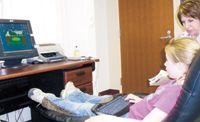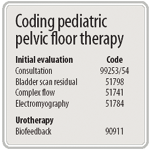Article
Interactive games help kids gain bladder control
Clearwater Beach, FL-Pelvic floor therapy-teachingchildren to control their bladders through various exercises thatinclude biofeedback techniques-has come of age, and PatrickH. McKenna, MD, has the statistics to prove its success.

"Ten years ago, I didn't believe in any of this," said Dr. McKenna, professor and chairman of the division of urology, Southern Illinois University School of Medicine, Springfield, at a recent seminar, "A Rationalized Approach to Incontinence Issues in Children: From Primary to Tertiary Care."
Today, Dr. McKenna is not only a believer, but an advocate and promoter of pelvic floor therapy to assist children in controlling incontinence, recurrent urinary tract infections, vesicoureteral reflux with voiding dysfunction, pelvic pain, frequency, dysuria, and constipation with voiding symptoms.

In children with persistent complaints, a key aspect of the treatment protocol is pelvic floor retraining, including standard biofeedback training and the use of updated devices keyed to computer games. The child using the computer-game-assisted biofeedback system scores points as he or she learns to control pelvic floor muscles associated with proper voiding control, Dr. McKenna explained.
Medical literature showing the benefit of biofeedback in pelvic floor muscle training is rich with success, he said, citing studies in which durable incontinence treatment was successful in a cohort of 162 patients (J Urol 2001; 166:1893-8).
"The majority of patients who did not improve have small bladder capacity," Dr. McKenna said.

In addition, the study demonstrated that the use of biofeedback and pelvic floor muscle training could resolve incontinence and decrease the number of urinary tract infections among patients with vesicoureteral reflux, he said. In a group of 53 patients with 72 refluxing units and lower urinary tract infection, a 90% decrease in infections and a 95% decrease in the need for surgical correction of the anatomical defects was achieved using these methods (J Urol 2001; 166:1439-43).
Data support approach
Dr. McKenna cited several other studies that support the use of biofeedback and pelvic floor muscle training in managing voiding dysfunction.





